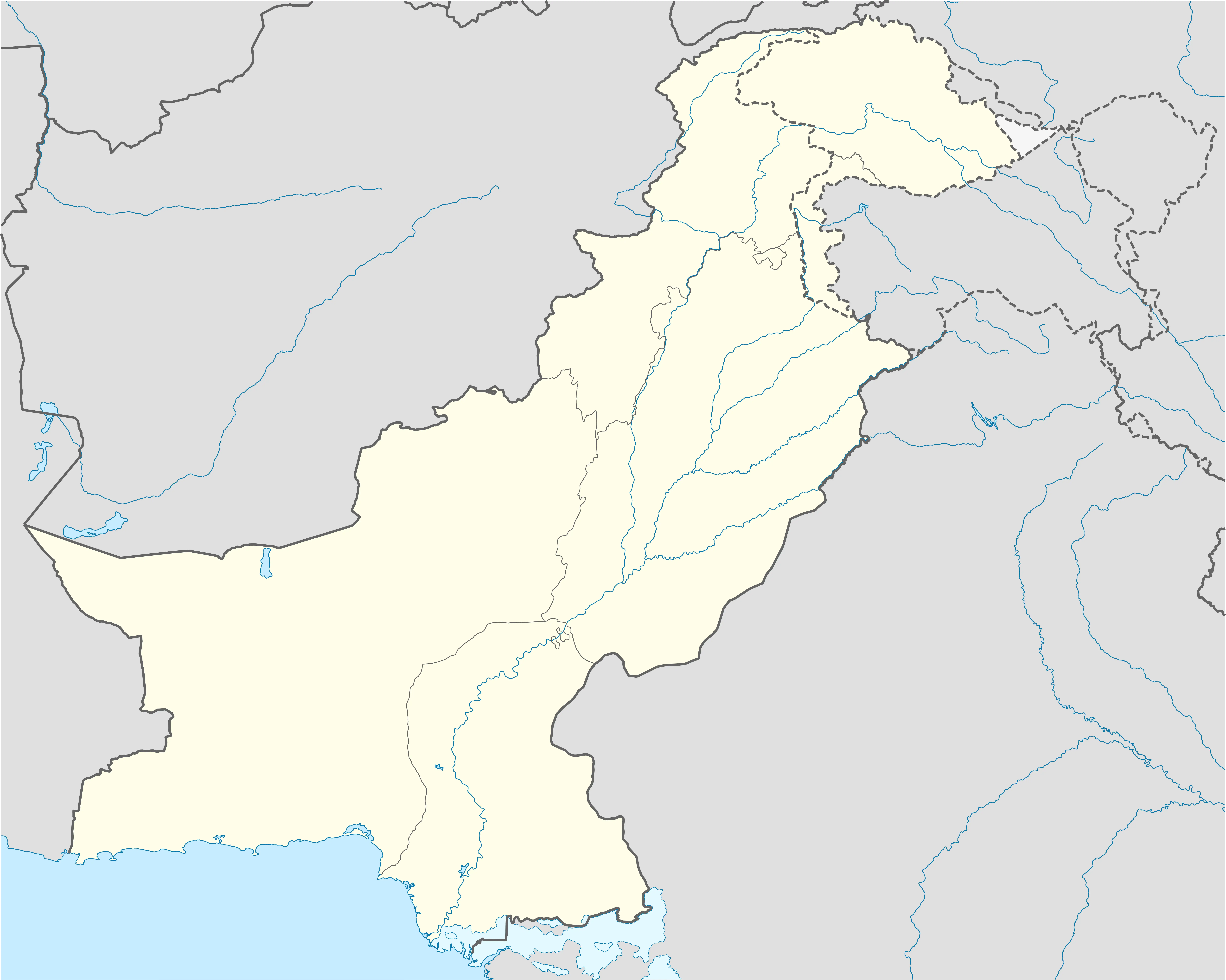Bhakkar
Bhakkar (Urdu: بھكّر), is the principal city of Bhakkar District located in Punjab, Pakistan. It lies on the left bank of the Indus River. It is the 86th largest city by population in Pakistan. It is famous for its mustard oil. Bhakkar was an important historical city. The towns of Bhakkar District are: Darya Khan, Dulle Wala, Kalor Kot, Mankera and Nawan Jandanwala.
Bhakkar
بھكّر | |
|---|---|
 Bhakkar Location in Pakistan  Bhakkar Bhakkar (Pakistan) | |
| Coordinates: 31°37′40″N 71°3′45″E | |
| Country | |
| Province | |
| Division | Sargodha |
| District | Bhakkar |
| Elevation | 522 ft (159 m) |
| Population | |
| • City | 113,018 |
| • Rank | 86th, Pakistan |
| Time zone | UTC+5 (PKT) |
| Calling code | 0453 |
| Union councils | 26 |
Administration
Bhakkar city is also the administrative centre of Bhakkar Tehsil one of the four tehsils of the district. Bhakkar Tehsil is subdivided into 17 union councils, three of which form the city of Bhakkar.[2]
History
Bhakkar was founded probably towards the close of the fifteenth century by a group of colonists from Dera Ismail Khan.[3] During the 15th century, Bhakkar saw a struggle for power between Hassan Malik and Naveed Asghar. It came under Humayun's rule after he restored the Mughal empire and he appointed Khan Khanan as the governor of the city alongside Multan,[4] as Multan was a province of the Mughal empire that included the city of Bhakkar.[5] it is on the name of Bakhar Khan.[6]
Fray Sebastian Manrique, a 17th-century traveller, travelled to this city in 1641 and described it as the capital of a Kingdom of Bhakkar.[7]

British rule
During British rule, Bhakkar Town was part of Bhakkar tehsil of Mianwali District. It was located on the left bank of the Indus River and was on the North-Western Railway line.[3]
The Imperial Gazetteer of India described the town as follows:
It stands on the edge of the Thal or sandy plain overlooking the low-lying alluvial lands along; the river, a channel of which is navigable as far as Bhakkar during the floods. To the west of the town the land is low, well cultivated, and subject to inundation, while to the east the country is high and dry, treeless, and sandy. A rich extent of land irrigated from wells lies below the town, protected by embankments from inundations of the Indus, and produces two or three crops in the year. The neighbouring riverain is full of date groves and fruit gardens; and in it stands a famous mango-tree, the fruit of which used to be sent to Kabul in the old days of Afghan rule. The municipality was created in 1874. Its income and expenditure during the ten years ending 1902–3 averaged Rs. 7,700. The income in 1903-4 was Rs. 7,500, chiefly derived from octroi; and the expenditure was Rs. 8,600. The population according to the 1901 census of India was 5,312, at that time the town contained a dispensary and a municipal vernacular middle school.[3]
Places to Visit
Dilkusha Bagh
There is an Old Date Orchard, locally known as 'Dilkusha Bagh' which is believed by some to be a Mughal garden built by Humayun, however Humayun never visited the area, on his retreat to Iran, he went to another Bakhar in Sindh to seek help from Mahmood Khan, which was however denied by historian Henry Raverty.[8]
Famous things of Bhakkar
Tail Karna
The flower is used in a multitude of ways, but the most common use is to make oil. Its essence is extracted and added to mustard oil while cloves, cardamom, jasmine and other spices are also added to the mixture. The resulting product is called ‘karna oil’ and is thought to be a quality product for treating a wide array of hair related issues such as dandruff and unnecessary shedding.[9]
Notable people
- Malik Ghulam Yasin Chhina (lawyer and social worker)
- Rasheed Akbar Khan Nawani (political person)
- Hassan Saghir, Finance Manager at PSL franchise Peshawar Zalmi & Zalmi Foundation.
- Muhammad Zafar Ullah Khan Dhandla (political person)
References
- "Pakistan: Provinces and Major Cities - Population Statistics, Maps, Charts, Weather and Web Information". citypopulation.de.
- Tehsils & Unions in the District of Bhakkar – Government of Pakistan Archived 9 February 2012 at the Wayback Machine
- Bhakkar Town – Imperial Gazetteer of India, v. 8, p. 44.
- S.R. Sharma 1999.
- Ashiq Muhammad Khān Durrani 1991.
- "District Website".
- Zulfiqar Ahmad 1988.
- Bhakkar District Official Website"Bhakkar". Archived from the original on 28 November 2016. Retrieved 22 October 2016.
- "karna oil treasure". 8 June 2019.
Bibliography
- S.R. Sharma (1999), Mughal Empire in India: A Systematic Study Including Source Material, Volume 1, Atlantic Publishers & Dist, pp. 124–235, ISBN 978-8-17-156817-8
- Zulfiqar Ahmad (1988), Notes on Punjab and Mughal India: Selections from Journal of the Punjab Historical Society, The University of Michigan, pp. 333–338
- Ashiq Muhammad Khān Durrani (1991), History of Multan: from the early period to 1849 A.D., Vanguard, p. 51, ISBN 978-8-17-156817-8